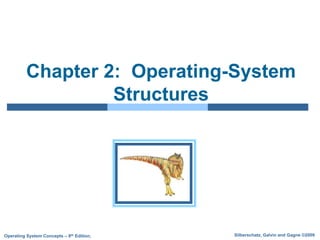This document discusses operating system structures as presented in Chapter 2 of the textbook "Operating System Concepts - 8th Edition" by Silberschatz, Galvin and Gagne. It covers the main services provided by operating systems, including user interfaces, program execution, I/O operations, file system manipulation and more. It also discusses system calls as the interface between processes and the operating system, and how they are implemented via system call numbers and tables. Parameters can be passed to system calls via registers or by addressing memory blocks.





































































